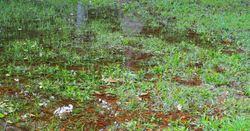
If you have a septic system, you probably know that it has a septic tank. But this isn’t the only component in your on-site waste treatment system. Other elements play a significant role in managing and treating your wastewater, and learning more about them can help you properly maintain your plumbing. Below is a brief guide to the anatomy of your septic system.
What Comprises Your Septic System?
1. Septic Tank
The septic tank serves as a storage and filtration chamber for your property’s wastewater. It is a sealed, watertight container made of plastic, concrete, fiberglass, or steel. Inside the tank, the sewage separates, with heavier solids sinking to the bottom as sludge, and lighter waste like grease and oil rising to form scum. Since solids remain in the septic tank, it requires cleaning and pumping at least every two years to prevent overfilling.
Apart from overflowing, septic tanks can also collapse or form cracks due to the weight of its contents. Fiberglass tanks are more prone to structural damage and shifting in the ground.
2. Distribution Box
 Once the sewage is filtered of solids, it flows out of the septic tank and into a distribution box. Sometimes called the flow divider, this device equally distributes the effluent into the leach field to prevent oversaturating one area. Incorrect installation of the distribution box often leads to uneven flooding and dryness, resulting in premature failure of the dispersal system.
Once the sewage is filtered of solids, it flows out of the septic tank and into a distribution box. Sometimes called the flow divider, this device equally distributes the effluent into the leach field to prevent oversaturating one area. Incorrect installation of the distribution box often leads to uneven flooding and dryness, resulting in premature failure of the dispersal system.
3. Leach Field
A leach or drain field is the final destination of wastewater after it has passed through the tank. It is where gray water gets further treatment from bacteria in the soil and is slowly absorbed back into the ground. Through a series of buried perforated pipes, the effluent disperses and gets filtered by gravel and stone.
When constructed without accounting for soil absorption rate or correct depth, a leach field can flood quickly or contaminate nearby aquifers. Be wary of standing water or swampy areas near the dispersal system—these are warning signs of a failing leach field.
4. Pipes
Pipes are essential in the efficient movement of the wastewater from start to end. They ensure that sewage remains inside a contained area to prevent the contamination of surrounding soil and nearby water source. When they sustain damage, effluent leaks out and causes pollution, leading to costly cleanups.
Whether you need help diagnosing a problem, or you’re due for regular pumping, turn to Mark Cromley Septic & Excavation Service in Lewisburg, PA, for top-notch upkeep of your septic system. For over three decades, they’ve provided septic tank maintenance, including cleaning and repairs, to clients throughout Union County. Call (570) 524-0249 for septic tank repairs or visit them online.
About the Business
Have a question? Ask the experts!
Send your question

